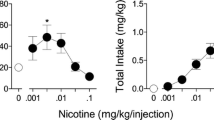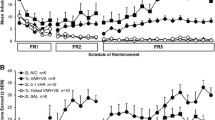Abstract
Background
A large reduction in the nicotine content of cigarettes may benefit public health by reducing the rate and the prevalence of smoking. A behavioral economics framework suggests that a decrease in nicotine content may be considered an increase in the unit price of nicotine (unit price = reinforcer cost/reinforcer magnitude). Increasing the price of cigarettes (i.e., increasing reinforcer cost) would be considered an equivalent change in unit price to reducing nicotine content (i.e., reducing reinforcer magnitude).
Objectives
The goal of the present experiments was to characterize the relationship between increases in nicotine cost and decreases in nicotine dose.
Materials and methods
A rat self-administration model was used to assess this relationship across three experiments, with an emphasis on very low nicotine doses to model a potential nicotine reduction policy. Cost was manipulated via changes in the number of responses required to earn an infusion.
Results
Results show that increases in the cost of nicotine and decreases in nicotine content were not equivalent manipulations. Nicotine consumption was more sensitive to nicotine dose than to nicotine cost. Nicotine consumption was also not equivalent across a variety of cost and dose combinations forming a single unit price.
Conclusions
Results of the present studies suggest that nicotine reduction is likely to have a large impact on nicotine exposure from cigarettes.



Similar content being viewed by others
References
Abreu ME, Bigelow GE, Fleisher L, Walsh SL (2001) Effect of intravenous injection speed on responses to cocaine and hydromorphone in humans. Psychopharmacology 154:76–84
Balster RL, Schuster CR (1973) Fixed-interval schedule of cocaine reinforcement: effect of dose and infusion duration. J Exp Anal Behav 20:119–129. doi:10.1901/jeab.1973.20-119
Benowitz NL, Henningfield JE (1994) Establishing a nicotine threshold for addiction. The implications for tobacco regulation. N Engl J Med 331:123–125. doi:10.1056/NEJM199407143310212
Benowitz NL, Henningfield JE (2013) ) Reducing the nicotine content to make cigarettes less addictive. Tob Control 22(Suppl 1):i14–i17. doi:10.1136/tobaccocontrol-2012-050860
Bickel WK, DeGrandpre RJ, Higgins ST, Hughes JR (1990) Behavioral economics of drug self-administration. I Functional equivalence of response requirement and drug dose Life sciences 47:1501–1510
Bickel WK, DeGrandpre RJ, Hughes JR, Higgins ST (1991) Behavioral economics of drug self-administration. II a unit-price analysis of cigarette smoking. J Exp Anal Behav 55:145–154. doi:10.1901/jeab.1991.55-145
Caggiula AR, Donny EC, Palmatier MI, Liu X, Chaudhri N, Sved AF (2009) The role of nicotine in smoking: a dual-reinforcement model. In: Bevins RA, Caggiula AR (eds) Nebraska symposium on motivation: the motivational impact of nicotine and its role in tobacco use, Springer Science + Business Media, vol 55. New York, NY, pp. 91–109
Carroll ME, Carmona GG, May SA (1991) Modifying drug-reinforced behavior by altering the economic conditions of the drug and a nondrug reinforcer. J Exp Anal Behav 56:361–376. doi:10.1901/jeab.1991.56-361
Chaloupka F, Warner KE (1999) The economics of smoking NBER Working Paper No 7047
Chaloupka FJ, Yurekli A, Fong GT (2012) Tobacco taxes as a tobacco control strategy. Tob Control 21:172–180. doi:10.1136/tobaccocontrol-2011-050417
Collier GH, Johnson DF, Hill WL, Kaufman LW (1986) The economics of the law of effect. J Exp Anal Behav 46:113–136. doi:10.1901/jeab.1986.46-113
Comer SD, Ashworth JB, Sullivan MA, Vosburg SK, Saccone PA, Foltin RW (2009) Relationship between rate of infusion and reinforcing strength of oxycodone in humans. Journal of opioid management 5:203–212
Conklin CA, Tiffany S (2002) Cue-exposure treatment: time for change addiction. 97:1219–1221. doi:10.1046/j.1360-0443.2002.00205.x
DeGrandpre RJ, Bickel WK, Hughes JR, Higgins ST (1992) Behavioral economics of drug self-administration. III A reanalysis of the nicotine regulation hypothesis Psychopharmacology (Berl) 108:1–10
DeGrandpre RJ, Bickel WK, Hughes JR, Layng MP, Badger G (1993) Unit price as a useful metric in analyzing effects of reinforcer magnitude. J Exp Anal Behav 60:641–666. doi:10.1901/jeab.1993.60-641
Donny EC, Taylor TG, LeSage MG, Levin M, Buffalari DM, Joel D, Sved AF (2012) Impact of tobacco regulation on animal research: new perspectives and opportunities. Nicotine Tob Res 14:1319–1338. doi:10.1093/ntr/nts162
Donny EC et al. (2003) Operant responding for a visual reinforcer in rats is enhanced by noncontingent nicotine: implications for nicotine self-administration and reinforcement. Psychopharmacology 169:68–76. doi:10.1007/s00213-003-1473-3
Donny EC et al. (2015) Randomized trial of reduced-nicotine standards for cigarettes. N Engl J Med 373:1340–1349. doi:10.1056/NEJMsa1502403
English JA, Rowlett JK, Woolverton WL (1995) Unit-price analysis of opioid consumption by monkeys responding under a progressive-ratio schedule of drug injection. J Exp Anal Behav 64:361–371. doi:10.1901/jeab.1995.64-361
ENVIGO (2008) Sprague-Dawley outbred rat. http://www.envigo.com/products-services/research-models-services/models/research-models/rats/outbred/sprague-dawley-outbred-rat/hsdsprague-dawley-sd/u.s.aspx. Accessed May 19 2016
Foster TA, Hackenberg TD (2004) Unit price and choice in a token-reinforcement context. J Exp Anal Behav 81:5–25. doi:10.1901/jeab.2004.81-5
Grebenstein P, Burroughs D, Zhang Y, LeSage MG (2013) Sex differences in nicotine self-administration in rats during progressive unit dose reduction: implications for nicotine regulation policy. Pharmacol Biochem Behav 114-115:70–81. doi:10.1016/j.pbb.2013.10.020
Grebenstein PE, Burroughs D, Roiko SA, Pentel PR, LeSage MG (2015) Predictors of the nicotine reinforcement threshold, compensation, and elasticity of demand in a rodent model of nicotine reduction policy. Drug Alcohol Depend 151:181–193. doi:10.1016/j.drugalcdep.2015.03.030
Hursh SR, Silberberg A (2008) Economic demand and essential value. Psychol Rev 115:186–198. doi:10.1037/0033-295X.115.1.186
Hursh SR, Winger G (1995) Normalized demand for drugs and other reinforcers. J Exp Anal Behav 64:373–384. doi:10.1901/jeab.1995.64-373
Hursh SR, Raslear TG, Shurtleff D, Bauman R, Simmons L (1988) A cost-benefit analysis of demand for food. J Exp Anal Behav 50:419–440. doi:10.1901/jeab.1988.50-419
Marsch LA, Bickel WK, Badger GJ, Rathmell JP, Swedberg MD, Jonzon B, Norsten-Hoog C (2001) Effects of infusion rate of intravenously administered morphine on physiological, psychomotor, and self-reported measures in humans. J Pharmacol Exp Ther 299:1056–1065
Nader MA, Hedeker D, Woolverton WL (1993) Behavioral economics and drug choice: effects of unit price on cocaine self-administration by monkeys. Drug Alcohol Depend 33:193–199
Nelson RA et al. (2006) Effect of rate of administration on subjective and physiological effects of intravenous cocaine in humans. Drug Alcohol Depend 82:19–24. doi:10.1016/j.drugalcdep.2005.08.004
Panlilio LV, Goldberg SR, Gilman JP, Jufer R, Cone EJ, Schindler CW (1998) Effects of delivery rate and non-contingent infusion of cocaine on cocaine self-administration in rhesus monkeys. Psychopharmacology 137:253–258
Rodgman A, Perfetti TA (2013) The chemical components of tobacco and tobacco smoke, Second edn. CRC Press ,Taylor & Francis Group, Boca Raton, FL
Rupprecht LE, Smith TT, Schassburger RL, Buffalari DM, Sved AF, Donny EC (2015) Behavioral mechanisms underlying nicotine reinforcement. Curr Top Behav Neurosci 24:19–53. doi:10.1007/978-3-319-13482-6_2
Smith TT, Levin ME, Schassburger RL, Buffalari DM, Sved AF, Donny EC (2013) Gradual and immediate nicotine reduction result in similar low-dose nicotine self-administration. Nicotine Tob Res 15:1918–1925. doi:10.1093/ntr/ntt082
Smith TT, Sved AF, Hatsukami DK, Donny EC (2014) Nicotine reduction as an increase in the unit price of cigarettes: a behavioral economics approach. Prev Med 68:23–28. doi:10.1016/j.ypmed.2014.07.005
Sorge RE, Clarke PB (2009) Rats self-administer intravenous nicotine delivered in a novel smoking-relevant procedure: effects of dopamine antagonists. J Pharmacol Exp Ther 330:633–640. doi:10.1124/jpet.109.154641
Sumpter CE, Temple W, Foster TM (2004) Comparing demand functions when different price manipulations are used: does unit price help? Learn Behav 32:202–212
Wakasa Y, Takada K, Yanagita T (1995) Reinforcing effect as a function of infusion speed in intravenous self-administration of nicotine in rhesus monkeys. Nihon shinkei seishin yakurigaku zasshi = Japanese journal of psychopharmacology 15:53–59
Wing VC, Shoaib M (2013) Effect of infusion rate on intravenous nicotine self-administration in rats. Behav Pharmacol 24:517–522. doi:10.1097/FBP.0b013e3283644d58
Woolverton WL, English JA (1997) Further analysis of choice between cocaine and food using the unit price model of behavioral economics. Drug Alcohol Depend 49:71–78
Acknowledgments
Thank you to Samuel Gutherz, Emily Pitzer, Elizabeth Shupe, E. Corina Andriescu, Kayla Convry, Samantha Cwalina, Dora Danko, Mackenzie Meixner, Jessica Pelland, Hangil Seo, Nicole Silva, and Marisa Wallas for their assistance in conducting the experimental sessions. Research reported in this publication was supported by the National Institute on Drug Abuse and FDA Center for Tobacco Products (CTP) (U54 DA031659 awarded to E.C.D.) The funding source had no other role other than financial support. The content is solely the responsibility of the authors and does not necessarily represent the official views of the NIH or the Food and Drug Administration. Funding for Tracy Smith was provided by the National Institute on Drug Abuse (F31 DA037643) and the National Cancer Institute (T32 CA186783).
Author information
Authors and Affiliations
Corresponding author
Additional information
Alan F. Sved and Eric C. Donny contributed equally and serve as co-senior authors.
Electronic supplementary material
ESM 1
(DOCX 29 kb)
Rights and permissions
About this article
Cite this article
Smith, T.T., Rupprecht, L.E., Sved, A.F. et al. Characterizing the relationship between increases in the cost of nicotine and decreases in nicotine content in adult male rats: implications for tobacco regulation. Psychopharmacology 233, 3953–3964 (2016). https://doi.org/10.1007/s00213-016-4426-3
Received:
Accepted:
Published:
Issue Date:
DOI: https://doi.org/10.1007/s00213-016-4426-3




